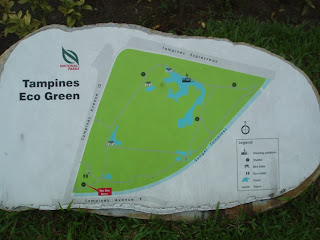For those who are expecting fast food joints nearby, lots of parking space and plenty of lighting for an evening walk, you will be quite disappointed as there is none of the above.
Even the toilet is not the normal kind you find in other parks as it is supposedly the first of its kind in an Nparks park – an eco toilet that makes use of composting to treat your waste. It has no water for washing. Instead you press for hand sanitiser gel from that wall dispenser. No water is available for flushing. Instead, wood chips are "dumped" into the toilet bowl to help in the composting process. For those who can’t get used to such a setup for your sanitary needs, a few portable toilets are located nearby. Personally, I prefer the well ventilated eco toilet to the tightly confined space of a portable toilet with its characteristic chemical odour. (Opps, I seemed to have said too much about the toilet rather than the WQM aspects of TEG.)
But for those who enjoy a relatively natural environment for their bird watching, firefly appreciation or WQM, TEG scores very high. Formerly made up of sand quarries (and I heard it was also used as a dumping ground), TEG is now marshes and shrubs. The trail is not gravel or dirt but a comfortable carpet of turf grass.
It is outfitted with a handful of ponds of yet to be examined water quality. A few seemed to be favoured by apple snails as evident from the pink clusters of snail eggs. Some were observed with pond skaters on the water surface and dragonflies skirting the above-water vegetation. As with the water quality, the kind of aquatic life below the surface has not been surveyed.
Figure: The roughly 2-km trail surrounds several ponds of unknown water quality.
Figure: "Pond 1", nearest to the entrance, is quite muddy.
Figure: "Pond 2" is starting to show signs of algal mat formation. Is it triggered by nutrients in the water? If so, where do the nutrients come from?
Figure 3: Clear (at least in the middle and right) brownish water suggests presence of dissolved organic matter e.g. tannins in "Pond 3".
Figure: Eco toilet with composting - supposedly first of its kind in Nparks jurisdiction
Figure: Bioswales like this one are found around the trails in the park. They are supposed to clean up the water draining through the park before discharging into a nearby canal. Are they effective? No one has tested them yet.














No comments:
Post a Comment